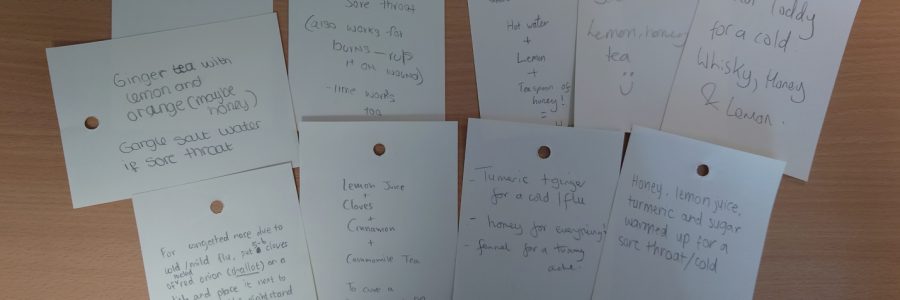
Cucumbers for Constipation and Vinegar for Verrucas: Curious Cures from the 21st Century
The University Library’s new exhibition – Curious Cures: Medicine in the Medieval World – delves into the intriguing, strange and sometimes improbable medical recipes from more than five hundred years ago. One of the pleasures of the digitisation and cataloguing project that inspired this exhibition was reading many a ‘curious cure’. By providing translations of recipes that have been written down on the pages on display, we hope to give visitors something of that experience of reading the words, seeing the writer’s hand before your eyes and entering – if for a brief moment – their mind and their world.
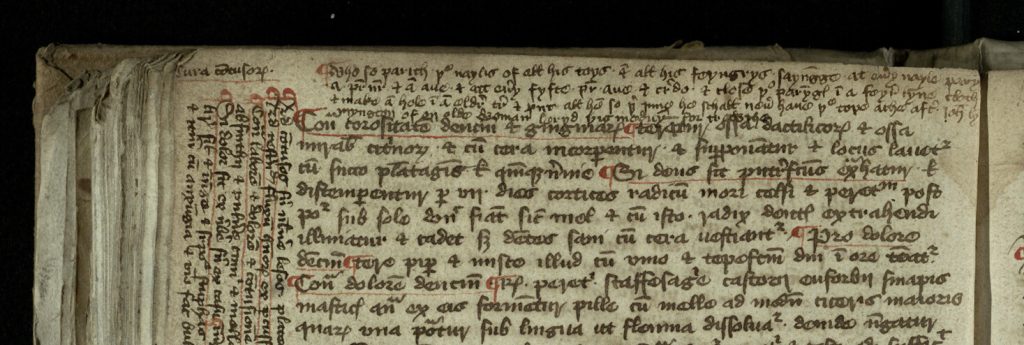
which he obtained from John Lymmington, another Carmelite friar, who learned it ‘off an old woman’
(Cambridge, Trinity College, MS O.8.2, f. 83v, top margin)
Of course, medical information was also transmitted orally in medieval times – and sometimes, remarkably, the manuscripts bear witness to medieval people talking, consulting and sharing their knowledge with one another. We see a Carmelite friar learning a ritual cure against toothache ‘off an old woman’. A Cambridge physician recorded his teacher’s use of a restorative on a cleric in his 40s, ‘whom all were saying could not be cured’. An anonymous compiler who travelled around northern England tells us of a cure for diarrhoea that he acquired from a deacon of Lancaster.
Everyone in the Exhibitions and External Engagement Team had some bit of medical lore that had been passed on to them in similar ways by family members, friends or acquaintances. Thus, an idea was born: what if we asked exhibition visitors to write down the sovereign remedies and healing advice they used themselves or that has been recommended to them? On the back of one of the display cases we provided pencils, paper and a pin-board – and then stood back and waited to see what would happen…
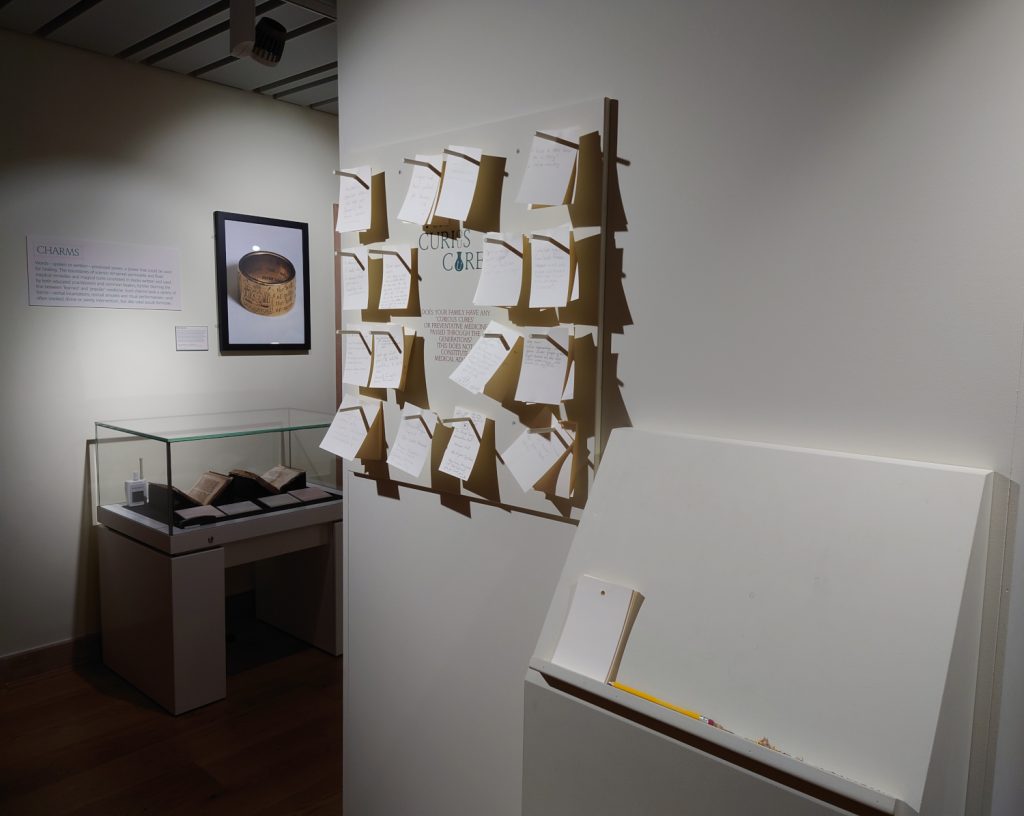
You can find it on the back of the large display case at the end of the exhibition room!
Since we opened our doors a month ago, we are delighted to have welcomed over 2,000 visitors to the exhibition – and we have been inundated with submissions: more than 200 recipes so far, with new additions appearing on the board as each day passes. Some of these are every bit as curious as the cures found in the medieval manuscripts. Three separate visitors claimed that you can get rid of a stye by rubbing it with a gold ring. Potatoes and onions crop up in several places: raw slices of potato on your forehead to deal with a temperature, potato skin on burns, half an onion applied ‘outside down’ on the ear to cure earache, or rubbing limbs with an onion to stop aches and pains. For constipation, one visitor advises you to eat nine cucumbers, ‘sometimes mini, sometimes not – let fate decide’. We shudder to think of the consequences. For verrucas, another instructs us to soak cotton wool in vinegar and tape it to the verruca overnight; remove and clean in the morning; ‘repeat until the verruca is dead and gone’. Perhaps the most implausible cure – also for verruca – comes to us third-hand: ‘Learnt not from family but elsewhere (I don’t know where): strap a woodlouse to the verruca/wart. It will eat it and it [the verruca] will be eaten away…’. How does one strap a woodlouse?!
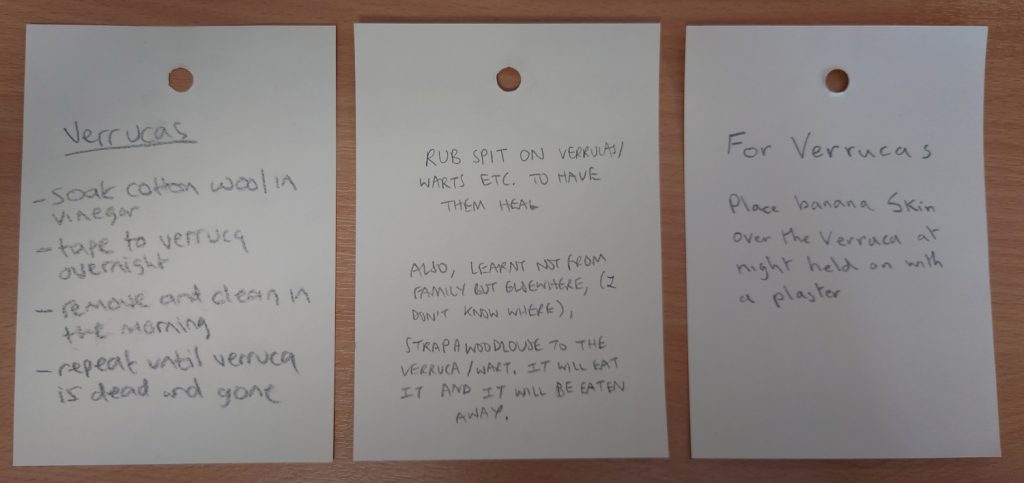
Here are some more highlights from what we’ve received so far. None of the contents should be taken as an endorsement or recommendation!
Panaceas
A notable number of submissions claimed miraculous curative properties for certain substances. Fans of natural remedies will be encouraged to know that nigella seed oil ‘will cure any illness but death’, while turmeric, arnica, tiger balm, echinacea and tea tree oil (‘one sniff a day’) are also effective against anything. Somewhat worryingly, alcohol was also frequently recommended: whiskey (add a cold shower, if feeling depressed), grappa mixed with milk (from an Italian visitor), plum brandy (from a Czech visitor), or simply booze of any sort (‘alcohol kills bacteria, right?’). One suggestion from the ‘scorched earth’ school of medicine is for the consumption of large quantities of chilli oil. We prefer the gentler ‘self-care’ methods that we’ve received: chocolate, ice-cream, television or a ‘duvet day’…
Coughs and colds
Perhaps unsurprisingly, the most common illness – prompting over fifty suggestions – was the humble cold and its various symptoms, such as sore throat, cough and congestion. Many people recommended a drink comprising honey, lemon and hot water, with variations also including crushed garlic or camomile, and spices such as ginger, fenugreek, turmeric or cloves. Fans of ‘hot toddy’ are advised to add brandy, whiskey or cognac. Several contributors mentioned gargling with salt water as a cure for sore throats. Inhalations of various sorts also appear: placing eucalyptus, lavender or potatoes (‘an East-Slavic remedy’) in boiling water and breathing in the steam as a decongestant. Placing half a dozen shallot cloves by one’s bedside helps to unblock your nose, too, we are told.
Soups comprised the most common bit of dietary advice. Chicken soup, garlic soup, congee (an east Asian rice porridge) with added ginger, chicken or pork, nettle and porcini soup (‘very Czech!’) and something called ‘swamp fever soup’…
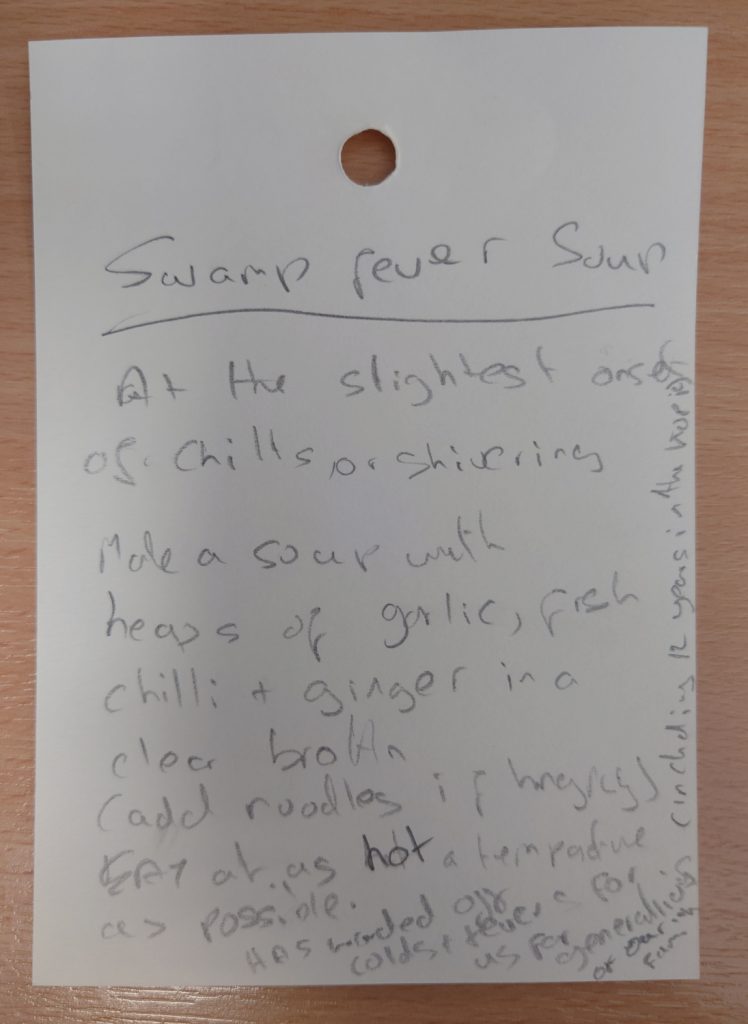
At the slightest onset of chills or shivering, make a soup with heaps of garlic, fresh chilli and ginger in a clear broth (add noodles, if hungry). Eat at as hot a temperature as possible. Has warded off colds and fever for generations in our family (including twelve years in the tropics).
There were some interesting cures from older generations, too. To cure a cold, one should eat boiled tripe and onions (from someone’s father, born 1922); eat half a raw onion and drink a glass of boiled lemonade (‘courtesy of my grandmother, who still swears by it at 102!’); swallow melted margarine and golden syrup (a remedy from the 1960s); or drink undiluted Ribena with toxic orange Lucozade three times a day (apparently it was better ‘before they removed sugar from everything!’). A more elaborate cure involves making a small hole in a beetroot, adding honey and leaving it to combine, then eating with a spoon (the beetroot must presumably be cooked first…).
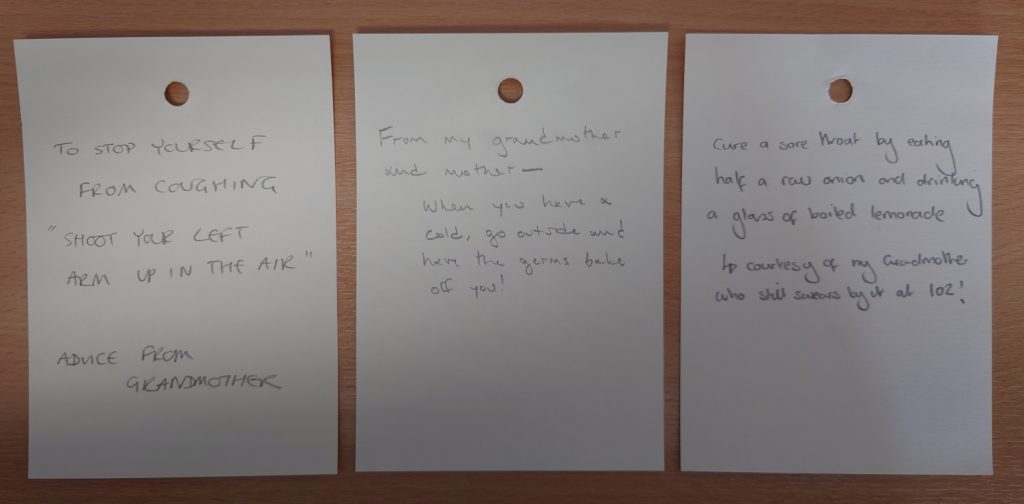
Curiously, family recommendations come more frequently from female members than male…
Another Italian visitor recommended ‘lana, latte, letto’: woolly jumper, milk, bed. Warm compresses against the neck or simply wearing a scarf are also helpful, we are told. A grandmother advises you to stick your arm in the air to stop coughing (does this really work?!); another suggests going outside ‘and have the germs bake off you’, which one suspects was equally effective against malingering.
Tough love
In similar vein, some modern domestic medical practitioners have sympathy and patience in short supply. ‘Drink a glass of water and go out for a walk,’ one suggests. For a grazed knee: ‘Slap it and get on with it!’ A more psychological approach comes from a mother dealing with any ailment on a weeknight (i.e. children not wanting to go school in the morning): go to the loo or have an early night and you’ll be better in the morning. ‘Works every time…’
Some visitors have evidently been on the receiving end of such untender ministrations and have seized the opportunity to lament their hardships. ‘Family cures (when your mum, sister and wife are doctors): antibiotics and paracetamol for everything; or, nothing and wait it out.’ An annotator added: ‘Also in this series: what to do when your husband is a hypochondriac.’ Another related their experience of breaking their arm and being given Calpol in response: ‘It required surgery to fix it. Morphine was better…’. A hard done-by pupil writes: ‘Severe brain damage at school? A wet paper towel will sort you out.’ And finally, another visitor wrote simply: ‘Never give up.’ Words to live by…
Do you have a home remedy that you swear by? Or a cure that has been passed down from generation to generation in your family? If so, we want to hear from you! The exhibition is open until 6 December and entry is free. If you can’t make it, please share your marvellous medicine by submitting a comment below. We’ll share some of the best submissions…

What a fascinating look at medieval medical remedies. It’s amazing how some old cures still resonate today, and I love the interactive touch of inviting visitors to share their own. Thanks for sharing.
here’s a remedy for hiccoughs, learned from something i read when i was a child. drink an entire glass of water upside down, in one go. which means you bend over, put the glass to your lips and drink the whole thing drink carefully completely without it going out your nose. it worked for me for many years, though the last time i tried it, sadly it did not. perhaps this is a cure for only the young who believe in it?